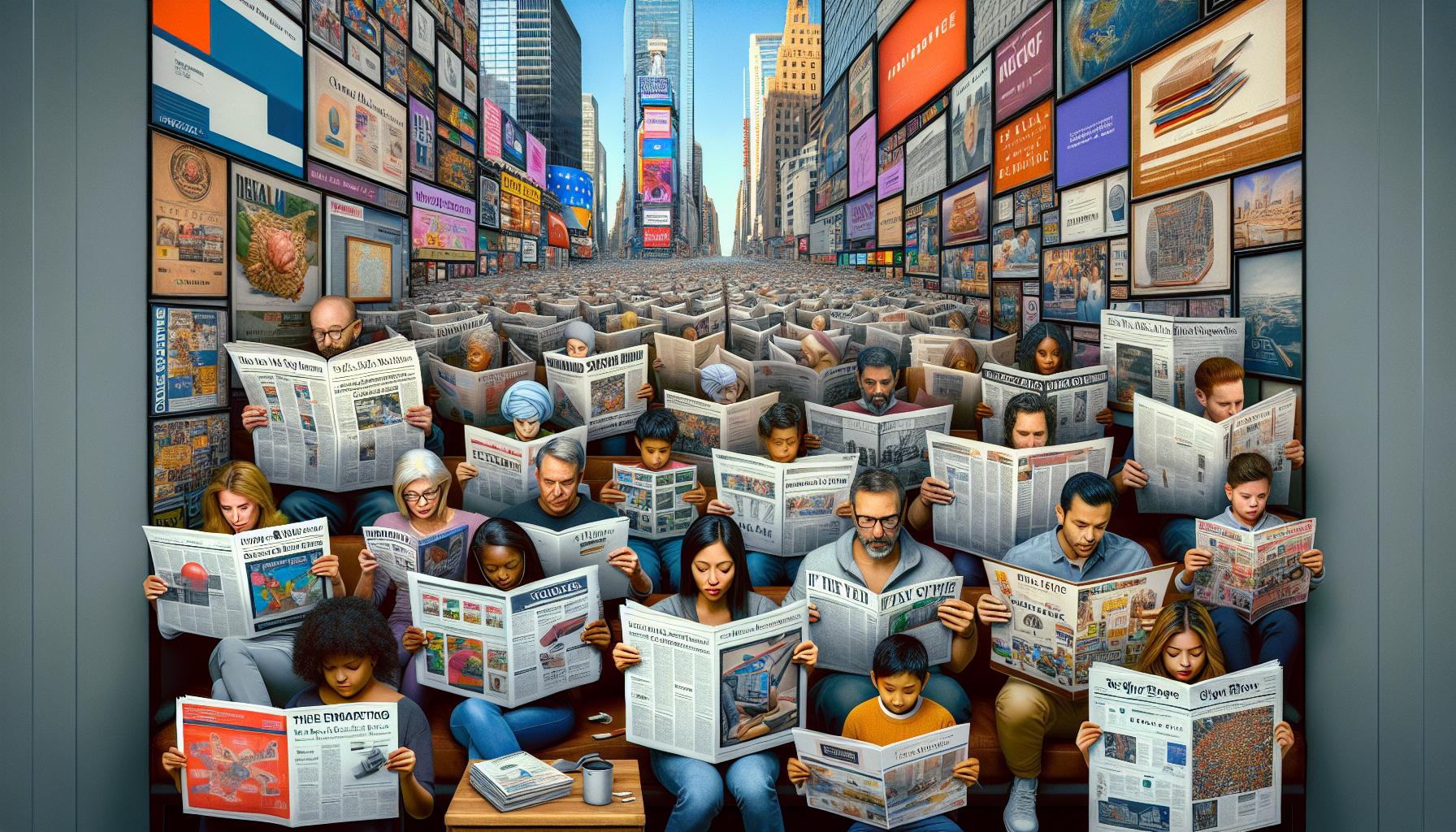Print media continues to play a vital role in communication despite the digital revolution. From newspapers and magazines to brochures and billboards these traditional forms of media reach millions of people daily delivering information entertainment and advertising messages.
The world of print media encompasses diverse formats that serve different purposes and target audiences. While some forms like newspapers focus on delivering current events and news others like magazines offer in-depth coverage of specific topics. Understanding these various print media examples helps businesses and organizations choose the most effective channels to reach their intended audience and achieve their communication goals.
Understanding Print Media and Its Role
Print media combines text images graphics on physical surfaces to communicate information to audiences. Newspapers magazines brochures posters catalogs books create tangible connections between content creators readers.
Core Functions of Print Media
Print media serves 3 primary functions in modern communication:
- Informs readers through factual reporting news articles investigative pieces
- Persuades audiences via advertisements editorials opinion columns
- Entertains through feature stories comics lifestyle content photographs
Key Characteristics
Print media demonstrates distinct advantages in content delivery:
- Permanence: Physical copies retain information without technology requirements
- Credibility: Established print publications maintain rigorous editorial standards
- Tactile engagement: Readers interact directly with printed materials
- Visual impact: High-resolution images graphics enhance message retention
Target Demographics
Print media reaches specific audience segments:
| Age Group | Preferred Format | Usage Rate |
|---|---|---|
| 55+ | Newspapers | 67% |
| 35-54 | Magazines | 58% |
| 25-34 | Catalogs | 42% |
| 18-24 | Brochures | 31% |
- Direct mail delivery to residential commercial addresses
- Retail outlet placement in stores newsstands
- Subscription services for regular delivery
- Event-based distribution at conferences trade shows
- Point-of-sale displays in business locations
Types of Traditional Print Media

Traditional print media encompasses diverse formats designed for mass communication through physically printed materials. Each type serves specific purposes based on content format requirements audience preferences.
Newspapers and Magazines
Newspapers deliver daily or weekly news coverage through broadsheet or tabloid formats that feature headlines news articles editorials advertisements. Major newspapers like The New York Times reach 9.2 million weekly readers through print distribution. Magazines focus on specialized topics with detailed articles high-quality images published weekly monthly or quarterly targeting specific demographics such as Time Magazine’s 1.6 million print subscribers.
| Publication Type | Average Circulation | Frequency |
|---|---|---|
| Daily Newspapers | 28.6M (USA) | Daily |
| Consumer Magazines | 122.9M (USA) | Weekly/Monthly |
Books and Textbooks
Books provide comprehensive content in bound formats ranging from 100-1000+ pages covering fiction nonfiction academic subjects. Textbooks present educational material with structured chapters learning objectives practice exercises tailored for specific grade levels subjects. Print book sales reached $10.2 billion in 2022 with textbooks contributing $3.1 billion to educational publishing revenue.
| Book Category | Annual Sales | Market Share |
|---|---|---|
| Print Books | $10.2B | 76% |
| Textbooks | $3.1B | 23% |
Brochures and Flyers
Brochures contain promotional information in bi-fold tri-fold formats featuring product details service offerings company information. Flyers present single-page announcements advertisements distributed through direct mail community posting locations retail environments. Marketing studies indicate 79% of consumers read direct mail brochures while 39% retain promotional flyers for future reference.
| Format | Response Rate | Cost per Response |
|---|---|---|
| Brochures | 5.3% | $0.94 |
| Flyers | 4.1% | $0.62 |
Modern Print Marketing Materials
Print marketing materials remain essential tools for business promotion with 82% of marketing professionals reporting successful campaign outcomes using printed materials. These tangible promotional items create lasting brand impressions through strategic design elements.
Business Cards and Letterheads
Business cards serve as portable brand ambassadors with 27.4 million cards printed daily in the U.S. Standard cards measure 3.5 x 2 inches featuring company logos contact information business names professional titles. Professional letterheads display consistent brand elements including:
- Company logos positioned at the top center or left corner
- Contact details aligned at the header or footer
- Corporate colors integrated throughout the design
- High-quality paper stock (24-32 lb weight)
Posters and Billboards
Outdoor advertising generates high visibility with 71% of consumers noticing roadside messages. Strategic placement considerations include:
- High-traffic areas averaging 50000+ daily views
- Weather-resistant materials for outdoor durability
- Size variations (30×40 inches for posters 14×48 feet for billboards)
- Digital printing technology for vibrant color reproduction
| Billboard Type | Average Daily Views | Cost per Thousand Impressions |
|---|---|---|
| Urban Highway | 100000+ | $3.38 |
| City Center | 50000+ | $4.72 |
| Rural Areas | 20000+ | $2.45 |
Direct Mail and Catalogs
Direct mail campaigns achieve 9% response rates surpassing digital marketing channels. Modern catalog formats include:
- Slim-line designs (8-12 pages)
- Product lookbooks with lifestyle photography
- Seasonal collections highlighting new merchandise
- Personalized mailers using variable data printing
- QR codes linking to digital storefronts
Each piece incorporates targeted messaging calculated delivery timing premium printing techniques to maximize engagement rates.
Digital Print Media Formats
Digital print media formats combine traditional print design principles with modern technology to create accessible content across multiple platforms. These formats enable publishers to reach broader audiences while maintaining the visual appeal of print materials.
E-books and Digital Publications
E-books represent a $17.8 billion global market with 1.1 billion digital titles sold annually. Popular formats include:
- EPUB files featuring reflowable text for optimal reading on various devices
- PDF documents preserving fixed layouts for academic publications
- Interactive magazines incorporating multimedia elements like videos
- Digital newspapers offering real-time updates through subscription platforms
- Academic journals providing searchable databases with citation tools
Digital publications achieve:
| Metric | Value |
|---|---|
| Average reader engagement time | 22 minutes |
| Global market share | 21% of all publications |
| Annual growth rate | 6.8% |
| Mobile device access | 68% of readers |
Print-on-Demand Products
Print-on-demand services generate $4.9 billion in revenue while reducing inventory costs by 30%. Common applications include:
- Custom photo books produced through online platforms
- Self-published novels printed per order
- Corporate training manuals created as needed
- Personalized calendars featuring client artwork
- Limited edition art prints with digital signatures
Production statistics show:
| Category | Turnaround Time |
|---|---|
| Books | 2-5 business days |
| Magazines | 3-7 business days |
| Marketing materials | 1-3 business days |
| Custom merchandise | 4-10 business days |
- Variable data printing for personalized content
- Cross-platform compatibility across devices
- Instant worldwide distribution capabilities
- Cost-effective small print runs
- Environmental benefits through reduced waste
Impact of Print Media on Business
Print media creates tangible business outcomes through strategic marketing campaigns by combining visual elements with targeted messaging. Companies leverage various print formats to achieve specific business objectives across different market segments.
Brand Building Through Print
Print media strengthens brand recognition through consistent visual elements across multiple touchpoints. Business cards showcase corporate identity elements to 57% of potential clients during first meetings. Corporate brochures retain reader attention for an average of 15.5 minutes, providing detailed brand storytelling opportunities. Marketing collateral featuring printed materials increases brand recall by 70% compared to digital-only campaigns. Physical marketing materials create lasting impressions through:
- Custom stationery designs incorporating brand colors fonts logos
- Professional brochures highlighting company values services expertise
- Printed newsletters maintaining regular client communication touchpoints
- Trade show materials creating immersive brand experiences
- Direct mail pieces delivering personalized brand messages
Print Media ROI
Print media generates measurable returns on marketing investments through multiple revenue streams. Direct mail campaigns achieve a 9% response rate compared to 1% for digital channels. Magazine advertisements deliver $3.94 return per dollar spent on average. Key performance metrics include:
| Metric | Performance |
|---|---|
| Direct Mail Response Rate | 9% |
| Magazine Ad ROI | $3.94 per $1 |
| Brand Recall Rate | 70% |
| Average Reading Time | 15.5 minutes |
| Sales Conversion Rate | 2.5x higher than digital |
- Targeted direct mail campaigns reaching specific demographic segments
- Magazine advertisements in industry-specific publications
- Local newspaper promotions increasing regional market presence
- Product catalogs generating direct sales responses
- Point-of-purchase displays influencing buying decisions
Future Trends in Print Media
Digital integration transforms print media through augmented reality (AR) features embedded in physical publications. Publications like National Geographic incorporate QR codes linking to interactive 3D models enhancing reader engagement by 47%.
Smart paper technology enables dynamic content updates on printed materials through electronic ink displays. These innovations create responsive advertisements updating prices real-time with 98% accuracy.
| Print Technology Trend | Adoption Rate | Market Value |
|---|---|---|
| AR-Enhanced Print | 35% | $4.2B |
| Smart Paper | 28% | $3.7B |
| Variable Data Printing | 62% | $8.9B |
| Sustainable Materials | 45% | $5.3B |
Personalized print experiences emerge through variable data printing technologies incorporating individual reader preferences. Marketing campaigns using personalized print materials achieve 41% higher response rates than generic alternatives.
Eco-friendly printing practices advance with biodegradable inks reducing environmental impact by 65%. Publishers adopt recycled papers meeting sustainability goals while maintaining print quality standards.
Print-digital hybrid models combine traditional formats with digital elements:
- Interactive magazine covers featuring embedded LED displays
- Newspaper sections with synchronized online content updates
- Product catalogs linking to real-time inventory systems
- Business cards containing NFC chips for instant digital contact sharing
- Direct mail pieces triggering mobile notifications
- AI-powered layout optimization reducing design time by 40%
- Robotic printing systems increasing output by 300%
- Smart distribution networks cutting delivery times by 50%
- Predictive maintenance reducing equipment downtime by 75%
- Cloud-based workflow management improving efficiency by 60%
Conclusion
Print media remains a cornerstone of effective communication and marketing strategies across traditional and digital platforms. From newspapers and magazines to innovative digital formats and print-on-demand solutions the industry continues to evolve while maintaining its crucial role in delivering information entertainment and promotional content.
The combination of tangible printed materials with emerging technologies like AR and sustainable practices demonstrates print media’s adaptability in meeting modern communication needs. With impressive ROI metrics strong brand recall rates and the ability to create lasting impressions print media proves its enduring value in an increasingly digital world.
The future of print media looks promising as it embraces technological advancement while preserving the unique benefits that make it an irreplaceable component of comprehensive marketing and communication strategies.
